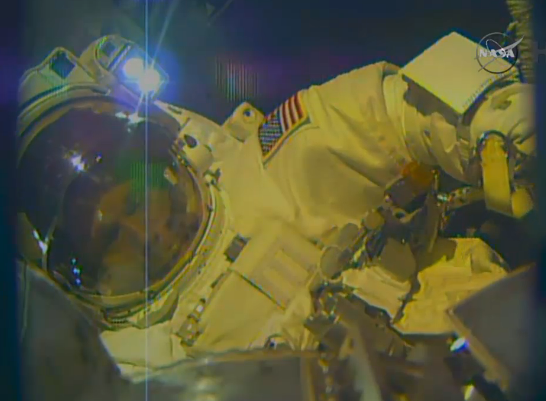
Expedition 42 spacewalkers Barry “Butch” Wilmore and Terry Virts returned inside the International Space Station (ISS) at 1:29 p.m. EST Wednesday, 25 February, wrapping up six hours and 43 minutes of multi-faceted activity on EVA-30. The duo finished the laying of cables in support of the future arrival of two International Docking Adapters (IDAs), removed a thermal and Micrometeoroid Orbital Debris (MMOD) cover from Pressurized Mating Adapter (PMA)-2, and moved on to independent tasks, with Wilmore readying the Tranquility node for the relocation and arrival of ISS modules later in 2015 and Virts masterfully working through a tricky lubrication of the Latching End Effector (LEE) on the 57.7-foot-long (17.6-meter) Canadarm2 robotic arm. Working more than 75 minutes ahead of the timeline, the spacewalkers breezed through their tasks, with several get-ahead activities completed ahead of Sunday’s scheduled EVA-31. However, whether that final spacewalk will occur remains in flux, following the worrying discovery of traces of water in Virts’ helmet shortly after repressurization.
Following on the heels of Saturday’s highly successful EVA-29—during which Wilmore and Virts spent six hours and 41 minutes laying and configuring about 340 feet (103 meters) of cables in readiness for the arrival of two International Docking Adapters (IDAs), later this year—the core tasks for EVA-30 were threefold. Firstly, the spacewalkers would work together to complete the “IDA Prep” cable work and remove the protective thermal and Micrometeoroid Orbital Debris (MMOD) cover from the Pressurized Mating Adapter (PMA)-2 at the extreme “front end” of the station’s Harmony node, prior to parting ways for their respective tasks. Wilmore would head to the Tranquility node to ready its forward and aft Common Berthing Mechanisms (CBMs) for the relocation of the Leonardo Permanent Multipurpose Module (PMM) in July and the arrival of the Bigelow Expandable Activity Module (BEAM) in September, whilst Virts would lubricate various components of the “sticky” Latching End Effector (LEE) on the station’s 57.7-foot-long (17.6-meter) Canadarm2 robotic arm.
The Expedition 42 crew—which, in addition to Wilmore and Virts, also includes Italy’s first woman in space, Samantha Cristoforetti, and Russian cosmonauts Aleksandr Samokutyayev, Yelena Serova, and Anton Shkaplerov—was awakened early Wednesday, and the U.S. Orbital Segment (USOS) team stepped smartly through the EVA Prep tasks. With Wilmore designated “EV1,” with red stripes on the legs of his Extravehicular Mobility Unit (EMU) for identification, and Virts (“EV2”) wearing a pure white suit, the spacewalkers underwent 60 minutes of “pre-breathing” on masks, during which time the inner “equipment lock” of the Quest airlock was depressed from its ambient 14.7 psi to 10.2 psi. Upon completion of this well-trodden protocol, the pair donned and purged their EMUs and the airlock’s atmosphere was repressurized back up to 14.7 psi.
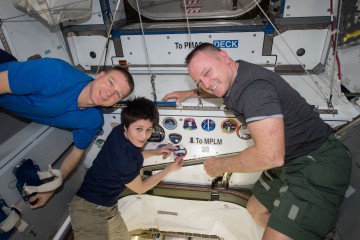
This enabled them to enter a nominal pre-breathing regime, lasting 50 minutes, followed by a further 50 minutes of In-Suit Light Exercise (ISLE). The latter was first trialed during the STS-134 shuttle mission in May 2011 and required Wilmore and Virts to flex their knees for about four minutes, rest for 60 seconds, then repeat until the 50 minutes were up. This technique serves to rapidly remove nitrogen from the bloodstream, thereby avoiding a potentially fatal attack of the “bends.”
Working at least 20 minutes ahead of the timeline, Cristoforetti moved the fully-suited pair and their equipment—including the Simplified Aid for EVA Rescue (SAFER) units, affixed to the lower section of their life-sustaining backpacks—from the equipment lock into Quest’s outer “crew lock.” Hatches between the locks were closed and depressurization got underway, reaching 5 psi at 6:25 a.m. EST and holding for a few minutes of checks, before resuming until the crew lock reached a condition of near-vacuum. EVA-30 officially began at 6:51 a.m., some 19 minutes ahead of schedule, when the spacewalkers transferred their suits’ critical life-support utilities onto internal battery power.
Within minutes, the pair—who are both seasoned spacewalkers, with Wilmore embarking on his third career EVA and Virts his second—had exited Quest and by 7:07 a.m. the thermal cover had been closed. They set about performing “buddy checks” to ensure that their suits, tethers, and equipment were in correct order, before moving on separate paths to the forward port of the Harmony node, at the extreme “front end” of the space station. Wilmore headed along the Crew and Equipment Translation Aid (CETA) Spur, whilst Virts made his way around the External Stowage Platform (ESP)-2, on the side of Quest, whilst Cristoforetti floated from the airlock and into the multi-windowed cupola to begin her intensive role in charge of Canadarm2 operations.
Guided by Capcom Joe Acaba and with the spacewalk overseen by Flight Director Greg Whitney and Lead EVA Officer Sarah Korona, the two astronauts reached PMA-2 within a few minutes and set to work as the ISS headed over Australia at 7:20 a.m. Working at least 30 minutes ahead of the timeline, Wilmore and Virts removed straps to the thermal and MMOD cover, noting that it had become somewhat rigidized since its installation by Expedition 32 spacewalkers Sunita Williams of NASA and Japan’s Aki Hoshide, back in September 2012. At length, they succeeded in folding the cover into a bag for transfer back to the airlock, then pressed on—with some difficulty—to complete the IDA Prep cable work. Wilmore experienced one troublesome connector and Virts moved to hold him in place, but at length Acaba reminded them that it was not a required IDA connection and the astronauts eventually wire-tied it out of the way and moved on with their next task.
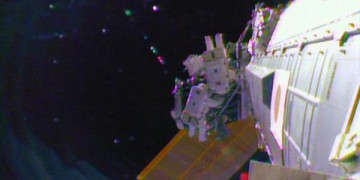
According to the timeline, the PMA-2 task was scheduled for 45 minutes and the completion of the IDA Prep work was allocated two full hours, but the spacewalkers moved speedily through their activities and returned their equipment bags and the bagged thermal and MMOD cover to the airlock in short order. Their view from their orbital perch, however, was truly spectacular, as evidenced for Wilmore and Virts’ Earthbound audience, who were treated to electrifying external ISS camera views and stunning images from the astronauts’ helmet-mounted cameras. As the station headed over Venezuela at 8:02 a.m., at an altitude of 257 miles (413 km), fellow astronaut Doug Wheelock tweeted “The view is certainly distracting … we do have a beautiful blue planet!”
The duo then parted ways and would spend the majority of the remainder of EVA-30 working on opposite sides of the ISS. Virts moved to ESP-2 to configure and ingress an Articulating Portable Foot Restraint (APFR), which would position him to begin the extensive lubrication of the LEE, which has become somewhat “sticky” in the 14 years since its April 2001 launch aboard Shuttle Endeavour on STS-100. NASA’s Rob Navias, who provided commentary throughout EVA-30, explained that it has proven sluggish over the past year, causing higher electrical motor currents, and described it as “a bit arthritic.” Mission Control had commanded Canadarm2 into the proper orientation a few days ago, close to ESP-2, but it was Cristoforetti who fine-tuned its position to place the LEE at eye-level for Virts to work on revitalizing it. By 10:10 a.m., Virts had configured the APFR and was ready to begin testing the tools he would need for the lubrication task.
Lubrication of the LEE was never intended to be done by spacewalkers, so a Ballscrew Lubrication Tool (BLT)—which consists of a probe, wire ties, and lots of tape—was employed by Virts to apply lubricant from a Grease Gun. Working “in the blind” at certain stages, it was intended that he would lubricate five portions of the LEE, including the ballscrews, equalization brackets, and latch deployment rollers for its four extended latches. He would also lubricate the Rigidized Central Ballscrew, which runs through the core of the LEE, and carried a quantity of EVA wipes to hand in order to clean up any fragments of grease which might escape. The LEE latches would then be retracted by Cristoforetti, thereby exposing the two linear bearing tracks. This would permit Virts to lubricate both sides on all four latches.
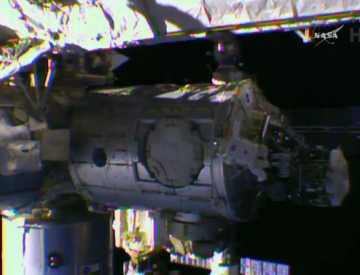
As Virts prepared for his BLT and Grease Gun tests, Wilmore began his move to the Tranquility node, stopping first at the port toolbox on the station’s Z-1 truss at 9:00 a.m., where he collected a socket. After briefly pausing to behold his reflection in an ISS radiator panel—prompting Joe Acaba to remark “You’re lookin’ good, Butch!” and even inspiring Rob Navias to quip “Butch Wilmore, admiring himself”—he headed prompty to Tranquility and was in place by 9:10 a.m. At this point in EVA-30, both spacewalkers were operating more than 75 minutes ahead of the timeline, raising the increasing likelihood that they would be assigned several “get-ahead” tasks to prepare for the complex EVA-31 on Sunday to install the Common Communications for Visiting Vehicles (C2V2) architecture.
His first activity was the detachment of a Non-Propulsive Vent (NPV), in which Wilmore used a Pistol Grip Tool (PGT) to remove four bolts, completing the work at 9:20 a.m. Working quickly, he replaced the NPV with a cover plate, which was in position about 15 minutes later, before pressing ahead with the removal of an obstructive handrail from the forward side of Tranquility. By 10 a.m., he was directed to release Launch Locks on the forward CBM and open a Centerline Berthing Camera System (CBCS) “flap,” which will allow for the robotic relocation of the Leonardo PMM in July. Within a half-hour, Wilmore had moved to Tranquility’s starboard CBM to repeat the task, again releasing Launch Locks and again opening the CBCS flap. Mission Control commanded the CBM “petals” to move to their 45-degrees-open position, then closed them, whilst Wilmore provided visual verification that the hardware performed as intended after more than five years in space.
As Wilmore worked at Tranquility, Virts was engrossed in the lubrication of the LEE, whose looming appearance bore more than a passing resemblance to one of the tentacled probes from “War of the Worlds.” The work produced a humorous tweet from the Canadian Space Agency (CSA), which carries primary responsibility for the arm. “Fill ’er up and kick the tires, pls!” they tweeted Virts. Despite suffering from an occasional cough, which NASA advised was of no concern, health-wise, the astronauts tested the BLT and expressed slight concern that he had “very little control.” Specifically, he highlighted the risk of hitting the LEE latches. Although non-critical, this certainly carried the potential to turn into something quite messy. At length, with Canadarm2 positioned in “the sweet spot” in front of Virts, he set to work. In spite of some grease liberation from the BLT, by 11:50 a.m. smooth movement had been reported on all four LEE equalization brackets. In total, he spent more than three hours on the lubrication work, using a scraper to remove flecks of grease from an electrical connector at one stage, and Canadarm2 was finally retracted away from him at about 12:55 p.m.
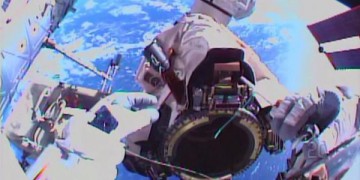
Meanwhile, with his work on the Tranquility node complete, Wilmore was directed to begin a get-ahead activity to pre-stage 18 wire-ties on the S-0 truss, preparatory to the C2V2 installation task on EVA-31. He completed this task at about the same time as Virts was wrapping up his lubrication of the LEE. It was decided that further get-ahead tasks—including the removal of a dimmed light from a camera port on the lower outboard face of the P-1 truss and the fitment of a handrail clamp over a known sharp edge, near the Quest airlock—would not be pursued on EVA-30. With all of their assigned tasks completed, Wilmore and Virts have now completed two of their three scheduled spacewalks, with the final EVA due to kick off on Sunday at 7:10 a.m.
However, the enormous success of today’s spacewalk ended with some trepidation, when water was detected inside Virts’ helmet, bringing back unpleasant reminders of the water intrusion incident experienced by Italian astronaut Luca Parmitano in July 2013, which led to the early termination of EVA-23. Priority was given to removing Virts’ helmet as quickly as possible, and it remains to be seen what impact this may have on the plans for EVA-31. Virts reported that he experienced no water in his helmet until the 5 psi point was reached during repressurization, and the quantity involved was far lower than that experienced by Parmitano. With the airlock repressurized, EVA-30 officially concluded at 1:34 p.m. EST, after a duration of six hours and 43 minutes. This now leaves Wilmore with a career total of 19 hours and 58 minutes of spacewalking, spread across three EVAs and Virts with 13 hours and 24 minutes, across two EVAs. As a consequence, Wilmore moves from 116th place to 82nd on the list of 211 spacewalkers, whilst Virts moves from 164th place to 115th. Should EVA-31—with a projected duration of 6.5 hours—go ahead on Sunday, it will elevate Wilmore into the Top 50 most experienced spacewalkers of all time
Want to keep up-to-date with all things space? Be sure to “Like” AmericaSpace on Facebook and follow us on Twitter: @AmericaSpace
Missions » ISS » Missions » ISS » EVA 29 »



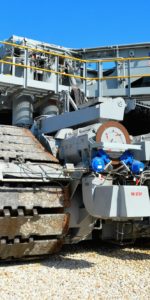
I wonder what kind of grease can withstand the temperatures in space and still function as a lubricant…? Doesn’t it get brittle at all in shade? How does it behave in the sun? Melt and escape?
On the fun side, John Travolta and Olivia Newton-John must be proud 🙂
Hi/r/ngood Post!!!!/r/n Thanks…
Join Now! http://sylwesterwpolsce.com